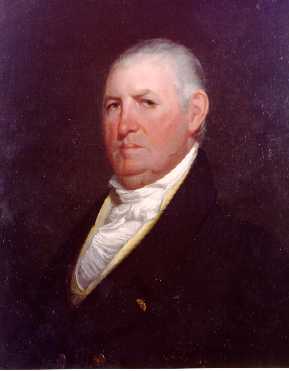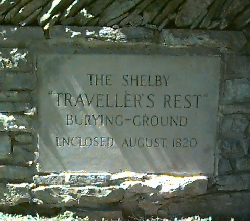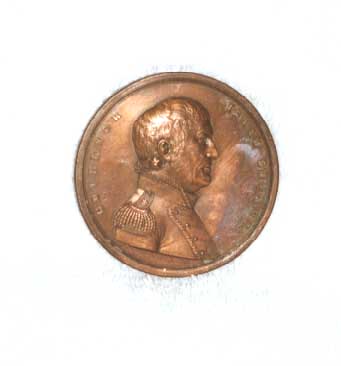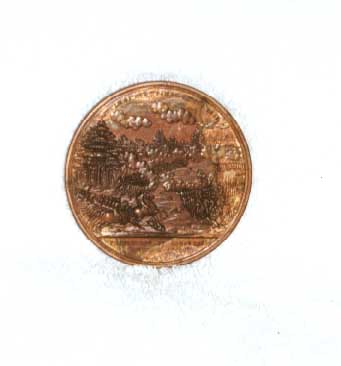

Isaac Shelby, soldier and first governor of Kentucky, was born near the North Mountain in Frederick (now Washington County, MD, the son of Evan and Laetitia (Cox) Shelby. Brought up to the use of arms, he early became inured to the dangers and hardships of frontier life. He received a fair English education, worked on his father's plantation, was occasionally employed as a surveyor, and served as deputy sheriff of the county. About 1773, the Shelby family moved to the Holston region of Southwest Virginia, now East Tennessee, where they established a new home.
Isaac Shelby served as a lieutenant in his father's Fincastle Company, at the battle of Point Pleasant, October 10, 1774, distinguishing himself by his skill and gallantry; his report of the action is one of the best contemporary accounts now in existence (printed in Thwaites and Kellogg). He remained as second in command of the garrison of Fort Blair, erected on the site of the battle, until July 1775, when he visited Kentucky and marked and improved lands on his own account, and also perfected ilitary surveys previously selected and entered by his father.
In July 1776, he was appointed by the Virginia committee of safety captain of a company of minutemen. In 1777, Governor Henry made him commissary of supplies for a body of militia detailed to garrison frontier posts. He attended the Long Island Treaty with the Cherokees, concluded at Fort Patrick Henry, on July 20, 1 777, at which his father was one of the Virginia commissioners. In 1778, he aided in furnishing supplies for the Continental Army and for the expedition projected by General Mcintosh against Detroit and the Ohio Indians. The following year, he provided boats for Clark's Illinois campaign and collected and furnished supplies - mainly upon his own personal credit - for the successful campaign waged about the same time against the Chickamauga Indians.
In the spring of 1779, he was chosen a member for Washington County of the Virginia legislature, and the ensuing fat!, Governor Jefferson made him a major in the escort of guards for the commissioners appointed to run the western boundary line between Virginia and North Carolina.
After various adventures in North Carolina and Kentucky, he went regularly into the army in 1780 and he distinguished himself, as commander of a body of three hundred men whom he had enlisted, in the warfare in Western North Carolina and Tennessee. For his service at King's Mountain, he received the thanks of the legislature of North Carolina with a beautiful sword. In 1782, he was a member of the legislature of North Carolina and later served as commissioner to settle claims on the Cumberland River and to lay off solders' lands near the site of Nashville. Then he went to Boons borough, Kentucky, where he married Susanna Hart.
He was a member of the convention which framed the first constitution
of Kentucky. Having participated in the separation of the State from Virginia,
and was elected the first Governor of Kentucky. He was again elected in
1812, and served four years. In 1813, he headed a body of 4,000 troops
under General Harrison and marched into Canada. He was then sixty-three
years of age, but for his gallantry at the battle of the Thames, Congress
gave him a gold
medal. In 1817, President Monroe offered to appoint him Secretary of
War, but he declined.
He died July 18, 1826. No less than nine counties in as many States
have been named after him as well as a number of towns.
Taken from: The Dictionary of American Biography, vol. IX (1935) and
to be found here.

The following text is the inscription from the monument at Traveler's Rest.
Shelby came to Kentucky in 1774 when he was hired by the Transylvania Company to survey the new Kentucky territory. In exchange for his services as a surveyor, Shelby was given his choice of land in the new territory and chose a large parcel of land in what is now Lincoln and Boyle counties, which he called Traveler's Rest.
Traveler's Rest was designed by Shelby and is thought to have been one of the first stone homes in Kentucky. The main wing was two stories high with single story wings extending from either end, one containing the master bedroom and the other the kitchen.
Traveler's Rest was accidentally burned in 1905 when the current owner tried to smoke out a wasp's nest in the attic. An engineer on a passing train saw the blaze and blew his whistle to alert the neighbors. However, the lack of water and a shortage of people to fight the fire resulted in the destruction of the house.
Shelby was a prominent member of early Kentucky society. He was a member of the constitution convention that led to Kentucky's statehood. Shelby was a trustee of Transylvania Seminary, Kentucky's first college, and chairman of the board of trustees of Centre College in Danville.
Shelby's military record was well known. He fought in the Revolutionary war at the famous Battle of King's Mountain and in the War of 1812.
Even after his official retirement from politics in 1816, Shelby was asked to serve as Secretary of War by President Monroe, however, he declined. In 1817 he was commissioned by Andrew Jackson to negotiate with the Chickasaw Indians for purchase of lands west of the Tennessee River.
Shelby remained active in political affairs until his death at Traveler's
Rest in 1826 at the age of 76. Shelby, his wife Susanna, several of their
children, and close family relatives are buried here.
From
this Kentucky State Site
Military Service
---------------------
Chapter XI - Northwestern North Carolina - Battle of King's Mountain
One of the most important events recorded in modern history was the victory gained at the battle of King's Mountain.
Cornwallis, commander-in-chief of the British army, expecting the conquest of North Carolina to follow the recovery of South Carolina, spread his troops to repress patriotic movements, and quickened Tory zeal on the left wing of his army, with Col. Ferguson, an officer with great energy and courage, in command of a large force toward the Alleghanies.
News of their movements was received in northwestern North Carolina and southwestern Virginia. Cols. Benjamin Cleveland, John Sevier, Isaac Shelby, Wm. Campbell, McDowell, Wm. Lenoir assembled the militia from the valleys of the Yadkin, Holston, Clinch, and New River, each commanding their respective regiments.
The country had to rely mainly for its defense on the skill and military genius of brave commanders and the valor, firmness and integrity of the militia which had to get in readiness in quick time. The honesty of purpose, the appreciation of homes, the love of families, welfare of the community, the freedom from oppressive laws, the enjoyment and possession of the blessings and happiness of inherited rights, will ever remain as garlands crowning officers and soldiers.
These gallant officers and men assembled in readiness to march. Col. Campbell was placed in command. After a rapid march they met the enemy. Col. Ferguson had taken position on King's Mountain, near the line dividing North and South Carolina. He stated he had taken the British command by surprise, and before Colonel Ferguson could be reinforced, Colonel Campbell and his brave home-defenders sat in their saddles thirty hours, with but few minutes intermission. Arriving at the foot of the mountain at day-light on the morning of October 7, 1780, they dismounted and marched up the mountain, after a fierce conflict, being repulsed three times. Colonel Ferguson made a daring attempt to break through the lines and was slain. One hundred and fifty of his bravest and best men fell before the mountaineers' unerring rifles. The survivors, eight hundred in number, surrendered. Twenty-five tories were hung. This battle was the turning point of the war. It crippled Lord Cornwallis' army, gave General Nathaniel Green time to get his command ready for action. The battle of Guilford was fought, the British army being defeated. Cornwallis surrendered to General Washington at Little York, Va. soon after.
General Isaac Shelby was originally from Maryland, and was with his father at the battle of Point Pleasant. He was the first governor of Kentucky, in 1802 and again in 1812
The TNGenWeb Project has an excellent page on the battle.
---------------------
THE
MUSTER AT SYCAMORE SHOALS It was at the Sycamore Shoals of the Watauga
that the Overmountain Men assembled on September 25, 1780. The muster included
approximately 1100 fighting men, who marched the next day over the mountains
in search of the British Major Patrick Ferguson and his Tory militia. Eleven
days later on October 7, 1780, the Overmountain Men led by Colonels John
Sevier and Isaac Shelby found Ferguson's army at King's Mountain, South
Carolina. In little more than an hour on that October afternoon Major Ferguson
lay dead, and his army defeated. The victory at King's Mountain has been
described as a crucial first link in a chain of events thatled to the eventual
surrender of the British forces in the Revolutionary War.
---------------------
The highest honor awarded by the Commonwealth of Kentucky is the Kentucky Colonel. The Colonels are Kentucky's ambassadors of goodwill and fellowship around the world.
Commissions for Kentucky Colonels are awarded by the Governor and the Secretary of State to individuals in recognition of their noteworthy accomplishments and outstanding service to a community, state or the nation. Click here for an example.
A list of Kentucky Colonels is a Who's Who of outstanding men and women around the world. The certificate, signed by the Governor and the Secretary of State and bearing the Great Seal of Kentucky, has hung on the walls of such distinguished leaders as President Lyndon B. Johnson and English Prime Minister Winston Churchill. America's first man in space, John Glenn, was commissioned while orbiting earth on his historic mission.
This tradition began in 1813 during the second term of Governor Isaac
Shelby, when he bestowed the title of Colonel to his son-in-law, Charles
S. Todd, a member of his staff. Shelby later issued commissions to all
who enlisted in his regiment in the War of 1812. Later, Governors commissioned
colonels to act as their protective guard; they wore uniforms and were
present at most official functions. (Today's colonels are not required
to perform such service.)


Links to Counties for Named
Shelby County, Kentucky Shelby county is located in the northwestern part of the Bluegrass region of Kentucky. It was formed in 1792 and named for Isaac Shelby. The county seat is Shelbyville.
Shelby
County, Tennessee Isaac Shelby was appointed Colonel commandant of
the new county by Governor Castle of North Carolina, subsequently became
the first Governor of the Commonwealth of Kentucky.
Shelby County in Tennessee: 751 square miles, population 826,330, was
named after Isaac Shelby Revolutionary War hero.
Shelbyville's name honors Revolutionary War hero Colonel Isaac Shelby,
who led a force of Tennessee riflemen at King's Mountain against the British.
The Duck River almost encircles the town, which is the leading business
and shipping center of the Duck River Valley.
Shelby
County, Texas A Spanish explorer named De Soto was the first white
man to enter this area when he crossed the Sabine River at what is now
Logansport, Louisiana, in 1539. The purchase of Louisiana by the United
States in 1803 resulted in a boundary dispute with Spain. The absence of
organized law provoked a conflict with the settlers and resulted in the
organization of a group called the Regulators and an opposition group called
the Moderators in 1842. Law and order was restored by militia under General
Sam Houston.
Shelby County is one of the original counties of Texas. We are located
in the eastern part of the state bordering what is now called Toledo Bend
Lake. This territory was a path for many of the early migrants into Texas
from the United States, many of whom settled here temporarily before proceeding
westward. It is said that the first permanent settler was John Latham,
who settled here in 1818 when the area was still under Spanish rule.
The present area of Shelby County was a part of the Municipality of
Tenaha when Mexico became independent of Spain in 1821, and the most important
town was Nashville which was created in 1824.
When Texas became independent from Mexico in 1836, the Congress of
the Republic of Texas created Shelby County, naming it after an American
Revolutionary soldier named Isaac Shelby. The county was organized in 1837,
and Shelbyville, which was once called Nashville, became the county seat.
In 1866 a legislative act was passed requiring all county seats to
be located in the center of the county. Center became the county seat and
was named for its central location.
The present Shelby County Courthouse was built in 1885 and is on the
National Register of Historic Places in Texas
Shelby County, Alabama Shelby County was created by an act of the Alabama Territorial General Assembly on February 7, 1818, from former Creek Indian territory ceded in the Treaty of Fort Jackson on August 9, 1814. It is located in the north-central part of the state and is bounded on the north by Jefferson and St. Clair counties, on the south by Chilton and Bibb counties, on the east by Talladega county and on the west by Bibb and Jefferson counties. About one-half of the county is in the mineral belt. The county is named for Isaac Shelby, first governor of Kentucky. The location of the first county seat was Shelbyville. In 1826 the town of Columbia changed its name to Columbiana and became the permanent county seat. Other towns and communities include: Calera, Pelham, and Montevallo, home of the University of Montevallo.
Shelby County, Shelbyville, Missouri County seat and zip code: Shelbyville 63469. Classification: Third class. Square miles: 501. Organized: January 2, 1835. Named for: Isaac Shelby, Kentucky governor and a Revolutionary War soldier.
Shelby County, Indiana Named for Isaac Shelby of the American Revolution www.indico.net Shelby County, Indiana.
Shelby County, Iowa Shelby County was named in 1851 by the General Assembly of Iowa after General Isaac Shelby, famous for serving in the Revolutionary War and the War of 1812 and becoming the first governor of the state of Kentucky.
Shelby County, Illinois 1827 January 23 Shelby County is formed. Named for Governor Isaac Shelby.
Shelby
County, Ohio Shelby County was established in 1819 with Hardin serving
as the first county seat.
The name Shelby came from General Isaac Shelby, an officer in the American
Revolution who was noted for his bravery and honesty, was elected Governor
of Kentucky.
The people of the county chose the name Shelby because many of them
were from Kentucky and admired General Shelby a great deal.
The county seat was moved to Sidney in early 1820 as a permanent location
on a 70 acre piece of land donated by Charles Starrett.
Cities and Places
SHELBYVILLE,
TEXAS Shelbyville is at the junction of Farm Road 417 and State Highway
87, seven miles southeast of Center in southeastern Sabine County. The
area was settled in the 1820s by people who came from Tennessee, and the
community was originally called Nashville. The community was the county
seat of Shelby County.
The Congress of the Republic of Texas changed its name to Shelbyville
in 1837, for Isaac Shelby of Tennessee.
Shelbyville was the scene of the beginning of the Regulator-Moderator
War,qv and most of the major battles of the feud were fought in its vicinity.
Shelby, North Carolina The City of Shelby, the county seat for Cleveland County, was named after Colonel Isaac Shelby. Colonel Shelby was known by the Indians as "Old King Shelby." The wilderness was Colonel Isaac Shelby's greatest teacher. The lessons he learned were later applied in the Indian Campaigns, during the American Revolution and in the War of 1812. Colonel Shelby was one of the heroes at The Battle of Kings Mountain. The hard lessons learned from the wilderness were likewise applied during peacetime. He led Kentucky in the movement to statehood, became the state's first governor, and served two terms.
His personal friend, President James Monroe, offered Shelby the Secretary of War in 1817. Shelby did not accept his offer because of his "advanced age." Visitors to Shelby's home included President James Monroe and Andrew Jackson. Colonel Isaac Shelby had cities and towns named after him in Mississippi, Indiana, Iowa, Michigan, Nebraska, Ohio, Virginia, and North Carolina.
After Shelby's death in 1826, many speakers in praising his accomplishments referred to him as the "George Washington of the West." Colonel Shelby is buried near Danville, Kentucky.
Shelby Township, Michigan A legislative enactment of April 12 1827 gave authority and the first township meeting was held at the double log house of Perez Swift on section 21 (23-24 mile/Van Dyke-Shelby). Calvin Davis presided, Abijah Owen was clerk and Joseph Lester Supervisor. Russel Andrus, William Arnold, Elias Wilcox Elon Dudley, and George Hanscom filled various offices that year. Shelby Township was named in honor of Revolutionary War hero and first governor of Kentucky, Isaac Shelby.
Camp Shelby, Mississippiis the largest state-owned and operated field training site in the United States.
Camp Shelby was established in 1917. The Post was named in honor of Isaac Shelby, Indian fighter, Revolutionary War hero and 1st Governor of Kentucky, by the first troops to train here, the 38th Division.
------------------------------------------------
MISC Data / Relations
http://www.mdarchives.state.md.us/msa/refserv/stagser/ssu1/html/ssu0065.html
Dates: 1763
3, No. 51A. Evan Shelby. FR. Resurvey on the Mountain of Wailes. From
LAND OFFICE (Certificates, Patented, FR) 3962
Accession No.: 40,283-156
MSA No.: S 65-139
Location: B5/10/1/
------------------------------------------------
Various Links and Interesting Shelby Sites
THE MASTER SHELBY
RESEARCHER
Shelby
Burial Site in Indiana With Indiana Shelby's Information
The
Shelby Net (North Carolina Civil War Era)
Shelby
Family Tree by Mom i.e. The Shelby Exchange
Geneology
Forum
Shelby
and Hart Family Papers at UNC Chapel Hill
Lincon
County / Logans Fort KY
Lincon
County KY History
Lincon
County Plaque KY
Officers
of the 27th Regiment Mississippi Infantry
More
on Kings Mountain Campaign
Kentucky
State Historical Site
Munce
Steele
Tevis
UK
Site
Robert
Niemeier
Phil
Rivera
BIXLER
Stiths
Sewell
Turner
Obituaries
of Schenectady, NY
Illinois
Land Records, 1800's , Lots of Shelby Purchases
Papers
/ Docs Index in Indiana
EVAN
WILEY SHELBY VIRGINIA ALMIRA SALLEE 1817--1875 1819--1903
Master List of Places
Named Shelby
SEARCH ENGINE LINKS
State
of Maryland Archives
Altavista
SNAP
Ask
Jeeves (not very good)
Yahoo,
5k hits, a real google
The Real Google Engine. It is most
Excellent
------------------------------------------------
Centre
College Archives
Negotiations
of the Chickasaw Treaty
created: Aug-2000, revised: January-2008
All quotes and information copied onto this page our directly linked and credited to the associated author's WWW site. Copyrighted material fully credited and linked under copyright law, fair use act, education. Hence you do not have my permission to use material on this page.
No standard at this date (September 2000) has been set for Citing Electronic Sources. The best efforts have been made to cite as requested, and in lieu of the current published source method.
Links found on this page may take you to another site that has no association with this site.
All of the above is posible due to the THE CONSTITUTION OF THE UNITED STATES Article I, Section 8.
"To promote the progress of science and useful arts, by securing for limited times to authors and inventors the exclusive right to their respective writings and discoveries; "
One Signer of the Constitution from Virginia: John Blair , that I am researching here as a quite possible ancestor.